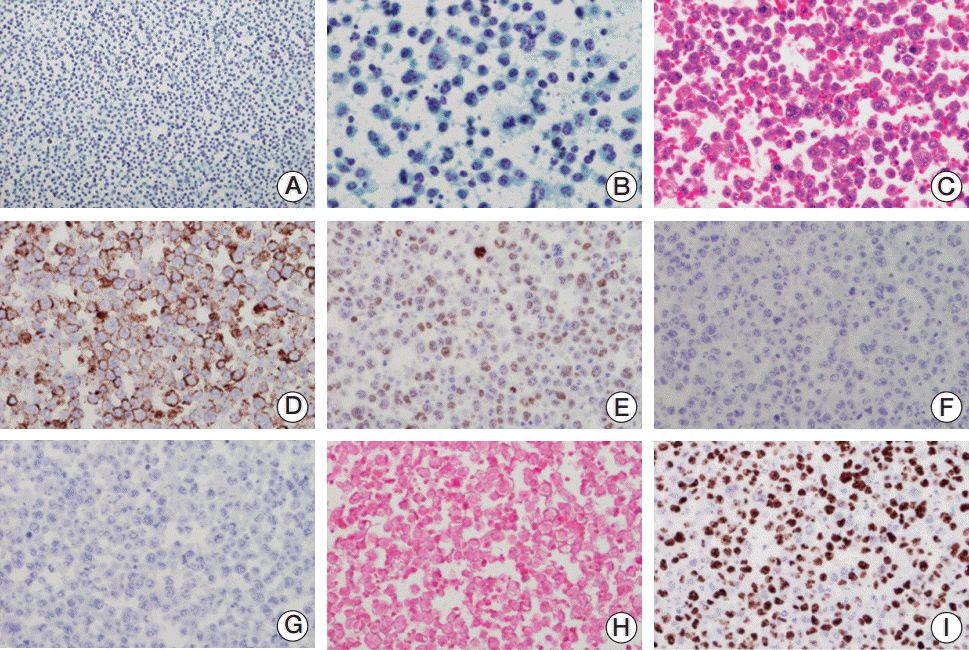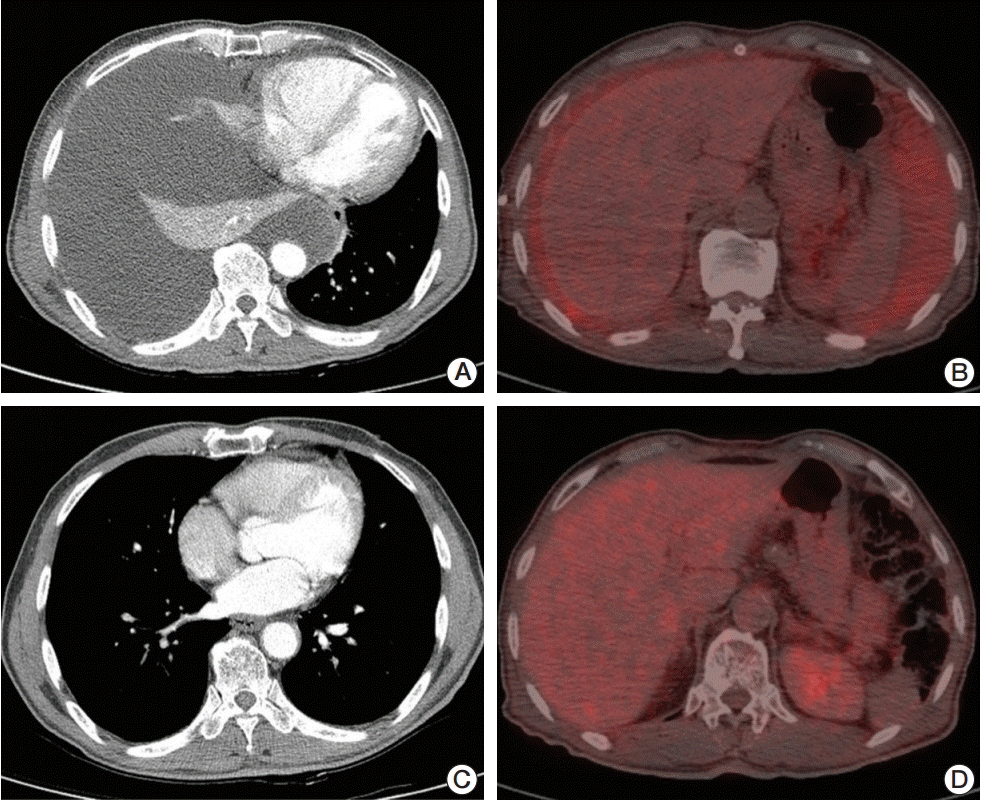Introduction
Primary effusion lymphoma (PEL) is a distinct type of non-Hodgkin’s lymphoma (NHL) presenting with a characteristic feature of pleural, peritoneal, or pericardial effusions without detectable tumor masses [1]. PEL is universally associated with the presence of human herpesvirus 8 (HHV8) within the neoplastic cells. Most cases are associated with immunodeficient states, particularly human immunodeficiency virus infection, which accounts for more than 75% of reported cases [2,3]. However, numerous cases of NHL with remarkable clinicopathologic similarities to PEL without evidence of HHV8 infection, and occasionally, without any factors predisposing to immunodeficiency have been reported [4-6]. This subset of cases, although rare, have been categorized separately and constitute a distinct disease entity referred to as HHV8-unrelated PEL-like lymphoma (PEL-LL). Differentiation of PEL-LL from PEL is important, as they appear to have distinct demographics, immunophenotypes, responses to treatment, and prognoses [5,7,8]. Herein, we report on an elderly male patient diagnosed with PEL-LL who received six cycles of rituximab plus cyclophosphamide, doxorubicin, vincristine, and prednisolone (R-CHOP) chemotherapy. To the best of our knowledge, this is the first report on administration of R-CHOP in a PEL-LL patient in South Korea.
Case Report
A 77-year-old male presented with abdominal distension and pitting edema of both lower limbs for 1 month. He had no complaints of respiratory symptoms, such as a cough, sputum, dyspnea, and no history of fever or chills. On examination, his abdomen was soft and distended, with shifting dullness on percussion, and decreased breath sounds were detected in the right lower lung field, without audible crackles or wheezes on auscultation. He had grade 2 pitting edema of both lower extremities, and there was no evidence of hepatosplenomegaly or enlargement of superficial lymph nodes. The hemogram was unremarkable, although the serum lactate dehydrogenase (LDH) level was elevated to 393 IU/L (reference range, 100 to 225 IU/L). The chest X-ray showed a large right-sided pleural effusion, and electrocardiogram and thyroid function tests were normal.
Both thoracentesis and paracentesis were performed. The pleural effusion contained 5,750/μL of red blood cells (RBCs) and 2,990/μL of white blood cells (WBCs). In the differential cell count, 82% of the WBCs in the routine cell count had an atypical morphology. The results of the chemical analysis of the pleural effusion were as follows: protein 3,833 mg/dL, glucose 13 mg/dL, LDH 6,000 IU/L, and adenosine deaminase 310 IU/L. The acid-fast bacilli smear and culture and real-time nested polymerase chain reaction for Mycobacterium tuberculosis complex DNA in both the pleural effusion and sputum showed negative results. No microorganisms were identified on Gram stain and from bacterial culture. Ascites contained 200/μL of RBCs and 10,880/μL of WBCs with 33% lymphocytes and 67% atypical cells. Results of chemical analysis showed a total protein of 3,908.9 mg/dL, albumin of 2,400 mg/dL, glucose of 34 mg/dL, and LDH of 3,476 IU/L. The serum-ascites albumin-gradient was 0.8 g/dL, and the Gram stain and bacterial cultures were negative.
The cytological evaluation of both the pleural effusion and ascites demonstrated numerous large and pleomorphic cells with eosinophilic macronucleoli and abundant cytoplasm, with an immunoblastic or anaplastic appearance (Fig. 1A-C). Tumor markers, including prostate-specific antigen (PSA), carcinoembryonic antigen, and carbohydrate antigen 19-9 were assessed in order to clarify the origin of the malignant effusion. Esophagogastroduodenoscopy (EGD), colonoscopy (CS), computed tomography (CT) of the chest, abdomen, and pelvis, whole body positron emission tomography–computed tomography (PET-CT), and bone scan were performed. The serum PSA level was increased to 7.713, while other tumor markers were within the normal range. EGD and CS detected some tubular adenomatous polyps, which were confirmed as benign. CT scans showed a large pleural effusion, contrast enhancement of the peritoneum, and prostatic enlargement (Fig. 2A). Therefore, a percutaneous drainage catheter was inserted into the chest, and a prostate biopsy was performed, which confirmed that the prostate tissue was benign. Diffuse hypermetabolism along the omental and peritoneal infiltration was detected on the PET-CT scan (Fig. 2B), and no significant abnormal uptake was detected on the bone scan.
On immunocytochemistry, the neoplastic cells in the pleural effusion were CD45-positive and cytokeratin-negative, and the tumor cells were positive for CD20 and MUM-1 with weak-to-moderate intensity and negative for CD138, CD79a, CD3, Bcl-2, Bcl-6, and HHV8. The Ki-67 proliferating index was approximately 90%. Epstein-Barr virus (EBV)–encoded small RNAs in situ hybridization showed no EBV-infected cells (Fig. 1D-I).
Serological tests were negative for human immunodeficiency virus (HIV), hepatitis B virus (HBV), and hepatitis C virus (HCV) and positive for anti–hepatitis B surface antibody with a titer of 141.2 IU/L, consistent with a history of HBV vaccination. Bone marrow examination detected hypocellular marrow (cellularity of 21%-30%) without evidence of lymphoma involvement, and cytogenetic examination detected a normal karyotype: 46,XY.
Based on the results described above, the patient was diagnosed with PEL-LL without concurrent HCV, HBV, or HIV infection. Six cycles of R-CHOP chemotherapy with symptomatic improvement was administered following the completion of therapy. The CT scan showed almost complete resolution of the pleural effusion and ascites with a decrease in the omental infiltration and peritoneal thickening with no metabolic activity on the PET-CT (Fig. 2C and D). The patient has been in a progression-free state for 15 months.
Discussion
Although PEL was first described in 1996 [9], the biological mechanism underlying the formation of a malignant effusion without detectable tumor masses is uncertain. This presentation is the most remarkable feature differentiating PEL from other types of conventional lymphomas. Development of PEL is provoked by HHV8 infection; however, the role played by HHV8 in lymphomagenesis remains to be clarified. PEL is one of the three major categories of HIV-associated NHL, accounting for approximately 1%-4% of HIV-associated NHL [2]. The diagnosis of PEL requires a cytological evaluation of the malignant effusion or the epithelial tissue lining the involved cavity, which shows large neoplastic cells with intermediate morphology between immunoblastic and anaplastic features [4,10]. These cells contain large nuclei with prominent nucleoli and variable amounts of basophilic cytoplasm. The immunocytochemical staining shows a lack of expression of pan-B-cell markers, including CD19, CD20, and CD79a. Universal expression of ORF73/latent nuclear antigen-1, the standard marker for detection of HHV8 infection, is required for making the diagnosis [3,4]. PEL is distinguished from Burkitt's lymphoma by its lack of c-myc proto-oncogene rearrangement [9]. In a recent cohort study, Notch1, a protein involved in a transmembrane signal transduction pathway, was proposed as a potential effector protein associated with the oncogenic process in HHV8-infected cells [3]. Although few studies describing the natural course in this subset of patients with PEL have been reported, the prognosis is considered extremely poor, and no optimal treatment has yet been established [10], with a median overall survival of less than 6 months [11]. Although few studies to identify prognostic factors associated with survival in patients with PEL have been reported, a retrospective literature review suggested a close association of the number and location of involved body cavities with overall survival [11].
The microscopic morphology of PEL-LL is similar to that of conventional PEL; however, there are several important differentiating factors. For example, PEL-LL is mainly associated with expression of conventional B-cell-markers, including CD19, CD20, and CD79a, usually occurs in older patients without concurrent immunocompromised conditions, such as HIV infection or organ transplantation, and, as its name implies, is not connected with HHV8 infection. PEL-LL is usually not accompanied by a viral infection; thus, its oncogenic mechanism is not well understood. Contrary to what is observed with PEL, PEL-LL cells usually carry c-myc amplification and show Burkitt-like morphology [9,11,12]. Therefore, lymphomagenesis is thought to involve multi-step genomic abnormalities. According to the most recent data, patients with PEL-LL show a better response to chemotherapy and a longer survival than those with PEL, with a median survival of more than 10 months compared with less than 6 months, respectively [9,13]. Despite the similarity in clinical presentation, it is unknown why PEL-LL has a better prognosis than PEL.
To date, approximately 50 cases of PEL-LL have been reported in the literature [7,13-15]. Most cases were HIV negative, and a small percentage were EBV and HCV positive, accounting for approximately 20% and 40% of cases, respectively [6]. In patients with positive serology for HCV, persistent antigenic stimulation of the virus is potentially responsible for the oncogenic process. However, a substantial number of cases without evidence of viral infection have been reported. More studies investigating the clonal origin of neoplastic cells and possible genetic precipitating factors are necessary in order to determine the mechanism of lymphomagenesis in such cases. Although the optimal therapeutic strategy is unclear, CHOP-based chemotherapy with or without rituximab has been used in a substantial number of cases [13]. In a previous literature review, the mean survival time for patients treated with CHOP or R-CHOP was 16.3 months (n=22), but only 12.5 months for patients without treatment (n=10) [13]. Several other treatment approaches have also been proposed in case reports or in small case series. One such example is a combination of rituximab and oral sobuzoxane and etoposide, which showed a promising result according to a Japanese case report [12].
Reports regarding either PEL or PEL-LL are rare in Asia. The first case report of a Korean PEL-LL patient was an 80-year-old female diagnosed with PEL-LL after treatment for tuberculous pleurisy who survived a long time without chemotherapy [15]. Our case demonstrated the typical clinical features of PEL-LL described in previous reports: the patient was elderly with no evidence of HBV, HCV, or HIV infection; the cancer cells expressed conventional B-cell markers including CD20; R-CHOP chemotherapy resulted in a good response, consistent with the earlier finding that chemotherapy is more effective for treatment of PEL-LL than PEL. However, considering the long survival of the patient in the previously reported case who was not treated with any anti-cancer agents, the role of chemotherapy in PEL-LL is unclear. Therefore, to establish practical guidelines for the treatment of PEL-LL, randomized trials with a large cohort are required to compare the efficacy of various therapeutic approaches.













